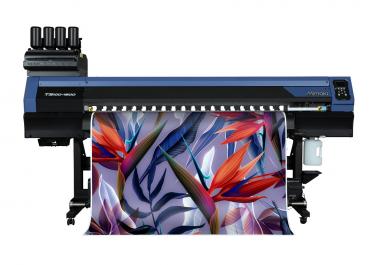Drupa: touchpoint textile zeigt Textildrucklösungen
Mit dem touchpoint textile hat die drupa ein Sonderforum geschaffen, das sich mit zukunftsweisenden Anwendungen im digitalen Textildruck beschäftigt. Highlight ist die Digital Textile Micro Factory - eine voll vernetzte, integrierte Prozesskette vom Kundenwunsch über das Design bis hin zum großformatigen digitalen Textildruck.
Der touchpoint textile repräsentiert die zunehmende Etablierung der drupa in neuen Märkten, die neben Textildruck Bereiche wie Verpackungsproduktion, Großformat- oder Industrie- und Funktionsdruck umfassen. Das Sonderforum beschäftigt sich mit den Chancen und Herausforderungen des digitalen Textildrucks, bringt Aussteller, Industriepartner und Brandowner zusammen und bietet Raum für branchenübergreifende Zusammenarbeit, neue Projekte sowie Produkt- und Fertigungsideen. Die Deutschen Institute für Textil- und Faserforschung Denkendorf (DITF), als Europas größtes Textilforschungszentrum, sowie der europäische Verband ESMA (European Specialist Printing Manufacturers Association) sind die operativen Content Partner des touchpoint textile.
Digital Textile Micro Factory: On-Demand und virtuelle Produkte – auf dem Weg zu einer nachhaltigen Produktion
Gemeinsam mit 12 Partnern aus Industrie und Forschung zeigt das DITF live auf der drupa eine Digital Textile Micro Factory und damit eine voll vernetzte integrierte Prozesskette vom Design bis zum fertigen Produkt. Diese präsentiert neue Möglichkeiten der Digitalisierung und direkten Kundeneinbindung, etwa in Form von 3D-Bekleidungssimulationen mit Vernetzung zu Design-Netzwerken für den kreativen Input. Digitale Workflows und virtuelle Produkte werden direkt in den Produktionsprozess integriert. Die Technologiepartner zeigen in der Microfactory eine automatisierte on-demand Fertigung, Textildruck, Zuschnitt und Absortieren – ohne manuelle Interaktion. Solche verteilten und digital vernetzten Design- und Produktionsketten werden es der Textilindustrie ermöglichen, in Zukunft gezielter auf Kundenwünsche und Trends zu reagieren: eine Zukunft ohne Ladenhüter. Für den gesamten Prozess von der virtuellen Entwicklung bis zum fertigen Produkt wird zudem der Carbon Footprint erstellt und auf der Messe dargestellt.
Erstmals wird 2024 der Design-Wettbewerb "drupa - textile design talents" stattfinden. Dieser wurde vom DITF konzipiert und durch den Partner Mitwill umgesetzt. Angehenden Textildesignern und Newcomern bietet sich dadurch die Chance, Ideen und Visionen einem professionellen Publikum zu präsentieren.
Unterstützung aus der Branche
Partner der Microfactory sind die Firmen Assyst/Deutschland (3-D Simulation digitaler Zwilling Bekleidung), Mitwill Textiles Europe/Frankreich (Kreatives Design-Netzwerk), D.G.I. Digital Graphics Incorporation/Südkorea, Multi-Plot Europe/Deutschland (großformatiger Textildruck), LEONHARD KURZ Stiftung/Deutschland, Zünd/Schweiz (digitaler Zuschnitt)/, robotfactory/Dänemark, Asco/Niederlande (mit einer innovativen Pufferlösung als Verbindung zwischen Digitaldruck und Zuschnitt, automatisiertes Absortieren der Zuschnittteile vom Cutter durch robotfactory) sowie Brother/Japan (für kleinformatigen Textildruck und Klebetechnologie). Als Sponsoren unterstützen Vaude und berger textiles den touchpoint. Weiterer wichtiger Partner ist die Hochschule Albstadt-Sigmaringen, die das Projekt konzeptionell unterstützt und sich den klaren Auftrag gegeben hat, diese neuen Themen in den Lehrplan zu integrieren. So werden die Mitarbeiter und Mitarbeiterinnen von morgen auf die neuen Herausforderungen vorbereitet.
Als weiterer Partner des touchpoint textile ist die European Specialist Printing Manufacturers Association (ESMA) für das Vortragsprogramm verantwortlich. ESMA vertritt den industriellen, funktionellen und Spezialdruck und organisiert Bildungsveranstaltungen im Bereich Textildruck. Auf der drupa behandeln Referentinnen und Referenten aus Forschung, Entwicklung und Industrie unter anderem Fragen zu Druck- und Veredelungstechnologien, Workflows, Marktentwicklungen oder Nachhaltigkeit. Im Fokus stehen auch Trends und Anwendungen, die durch das Zusammenspiel von Digitaldruck und textilen Bedruckstoffen immer neue Potenziale erschließen. Die Vorträge gliedern sich in die Themenbereiche Research, Finishing, Print Systems & Hardware, Substrates, Inks & Chemistry und Software & Electronics. So hält zum Beispiel Assyst Vorträge über virtuelle Entwicklung von Bekleidung sowie das Forschungsprojekt ECOShoring, das durch die Deutsche Bundesstiftung Umwelt – DBU gefördert wird, mit dem Schwerpunkt auf On Demand und individualisierte und nachhaltige Fertigung. Adobe, Balta Group, Barbieri Electronic, Brother, Centexbel, CST, DITF, Fujifilm Speciality Ink Systems, HS Albsig, Kornit Digital, Meteor Inkjet, Mimaki, Mitwill, Multiplot, Print-Rite, RWTH Aachen, Seiko Instruments, Tiger Coatings, Xaar und Zünd stellen ebenfalls hochkarätige Speaker für das Konferenzprogramm. Die Liste wird fortlaufend ergänzt.
Die drupa findet vom 28. Mai bis 7. Juni 2024 auf dem Düsseldorfer Messegelände statt.
Messe Düsseldorf


















